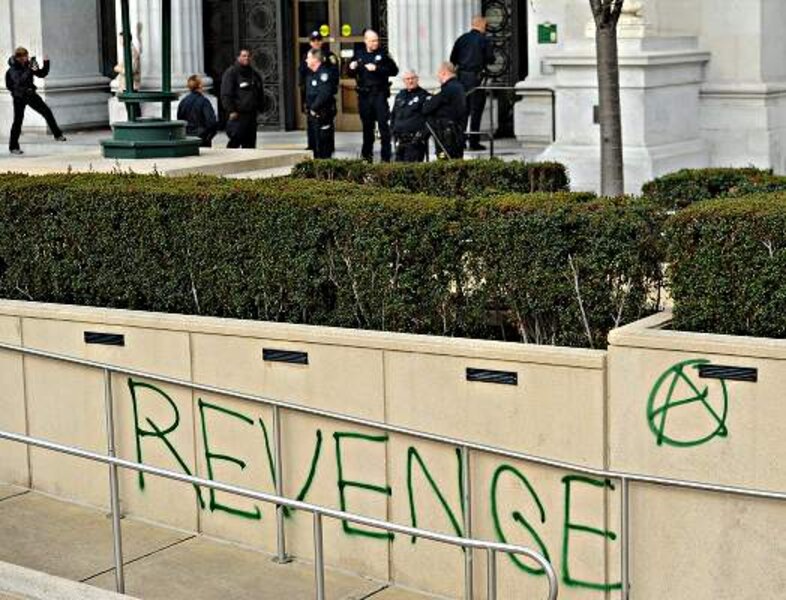Occupy Wall St. nonviolence: Is Oakland the exception or the future?
Loading...
| Los Angeles
As Occupy groups in Washington and Oakland generate contrasting images of Dream tents on the one coast and flag burning on the other, it’s becoming clear that the four month-old protest movement is facing its Hamlet moment: to be or not to be nonviolent.
This is the question groups throughout the now global movement have been tackling urgently – and, increasingly – formally.
But despite pleas from many, including the movement’s earliest members, there is no unity on this thorny, even decisive, issue.
“Occupy’s strength has been that as a movement dedicated to nonviolent direct action it claimed to follow in the footsteps of Martin Luther King, Jr.,” says Catherine Wilson, a political science professor at Villanova University in Philadelphia, via email.
Broadcast footage of violent clashes between demonstrators and law enforcement officers undermines this goal, she says, adding that while the actions of Occupy Oakland only represent one group, they do signal the difficulty of keeping a variety of Occupy’s factions on the same nonviolent page.
“If violent encounters spread,” notes Professor Wilson, “this will call into question the whole model of peaceful reform that Occupy seeks to implement.” Increased violence by Occupy supporters, she adds, “would only serve to delegitimize the movement as a whole.”
[ Video is no longer available. ]
Members of Occupy Washington DC – the earliest such group, formed a month prior to the Adbusters campaign in July that launched the larger Occupy movement – adopted formal principles of nonviolent action from its inception.
Taking its cue from the Albert Einstein Institution, a Boston organization devoted to disseminating formal principles of nonviolent social change, the DC Occupyers created a formal pledge of 11 principles.
“People had to sign the pledge in order to join the encampment,” says Kevin Zeese, a lawyer and one of the group’s earliest members. These tenets are not icing on the cake of activism he says, “they are critical.”
Without strict adherence to the formal practice of nonviolent response, even to the most aggressive kinds of provocation up to and including rifle fire, Mr. Zeese says, “this movement would have achieved nothing.”
He points to key moments in the Occupy movement’s short history, such as pepper spray incidents in lower Manhattan and UC Davis. In both those cases, he says, “if those girls in New York had done anything either to provoke or respond there would not have been the outcry or attention there was.”
Similarly, he says, if the students at the UC Davis campus had thrown things at the police or even called them names, “they would not have made the impact they did just by sitting quietly.”
This view however, is not a simple sell throughout the movement. Activists in Oakland have declined to adopt an explicit nonviolent code.
“We embrace a diversity of tactics,” says Shake Anderson, a member of the Occupy Oakland media team, adding that this stance flows directly from its adherence to being a “non-hierarchical group with no single person telling anyone else what to do.”
This attitude also stems from a narrower definition of violence.
“I consider violence to be something that actually harms another human being,” he says, adding that if a group member chooses to burn a flag or break a window, “I don’t call that violent.”
More important, adds Anderson, is the inclusiveness of a group that allows for more than one strategy for achieving a goal.
The Occupy group in Seattle broke apart over this very issue, declining to adopt a platform of nonviolent tactics in December. The decision, reached during a general assembly, angered and frustrated many, not just within the movement, but among supporters in the community.
Father Mike Jackson, an assisting priest at St. Mark’s Episcopal Cathedral and the liaison for the Occupy group, posted an open letter to Occupy Seattle, informing the group that he and many others in the community would step back from their support if the group did not embrace a nonviolent position.
While the group has not changed its decision, Jackson notes that a number of nonviolent training sessions have sprung up in the community. “We’re hoping that this will help equip them to make a better decision,” adds Father Jackson.
The next generation seems to have gotten the message, however. The national group, Occupy Colleges, requires new recruits to adopt an official nonviolent approach, explaining on its website:
“As a nonviolent movement, we have agreed to refrain from violence against any person, from carrying weapons, and from destruction of property.
“We reject violence, including property destruction, because we recognize that it undermines popular support and discourages the broadest possible participation among the 99 percent.”







